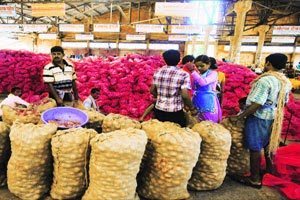 |
| Photo Source: The Economic Times |
The
impending 16th Lok Sabha election is going to be one of the most
promising and extravagant events in Indian political history costing its exchequer
about Rs 3,500 crores, excluding the expenses on security and individual
political parties. The post-election scenario therefore legitimately awaits a new
phase of Indian political-economy. It
beckons the hope of millions to find ways for economic recovery and job upturn,
especially for the growing youth population in India, when present demographic
profile is almost divided into two halves, the youth and the rest, a large part
of which needs immediate attention for productive economic engagement.
According to National Sample Survey Organisation
(NSSO), in 2011-12
unemployment rate (ratio of total unemployed to total laboure force) in usual
status is nearly 2 percent at all-India level with about 2 percent in rural
areas (for both male and female) and about 3 percent in urban area (3 percent
for males and 5 percent for female). Thus with estimated 40 percent population
belong to labour force as per the NSSO, India has a little high about 80 lakhs
unemployed. The youth unemployment scenario is even worse, and according to
Labour Bureaue estimates in 2013 about 4.7 percent is the youth unemployment
rate in India with 4.4 percent in rural area and 5.7 percent in urban area. The
all-India Youth Labour Force Participation is 50.9 percent with 52.8 percent in
rural sector and 46.1 percent in urban sector. Amongst them, female LFPR is
significantly lower (22.6 percent) as compared to male (76.6 percent) under the
usual principal status approach. For 15-29 years age group, Labour Force
Participation Rate and Unemployment Rate under the usual principal status
approach is estimated to be 39.5 per cent and 13.3 per cent respectively.
Such alarming situation is primarily for poor sectoral economic performance in India. For example, job creation in 2013 is worst affected with the manufacturing sector being the worst hit by the slowdown and projects being stuck due to lack of clearance and approval. Thus Indian companies have hit a three-year slump as slowing economy persists where a large number of development projects remain stalled despite the government trying its best to get them moving amidst efforts to accelerate investment and get growth back on track. The decline in hiring in 2013 was visible in sectors such as automobiles, capital goods, tyres, shipping, paper, construction, power generation and retail in line. Similar is the situation even in service sector, where job has declined by 31 percent by 2012, mostly from IT, telecom, financial services and hospitality services. A drop in GDP percentage from about 9 percent to about 4.5 percent from 2011 to 2013 had alarmingly taken away about 30 lakhs jobs from Indian market.
Despite persistent attempts by the UPA government to face such challenge through several centrally sponsored schemes like Swarna Jayanti Shahari Rozgar Yojana for urban India, and Mahatma Gandhi National Rural Employment Guarantee Act, Sampoorna Gramin Rojgar Yojana, Swarna Jayanti Gram Swarozgar Yojona for rural India, joblessness, especially amongst the youths remains a glaring issue. There possibly needs a much robust approach and planning where job creation needs to feature as a prime element in any development policy in India. It is being argued that non-farm job creation and productivity growth are fundamentals with more labour-intensive manufacturing, construction and service units. There are four major areas, where India can depend in the next phase of change, viz., IT, telecom, healthcare, infrastructure and retail. High-value-added manufacturing sector and increasing non-farm sectors, reformed labour laws in informal sector and raising shares of organized enterprises, linking skill-development prograrrme to all centrally sponsored schemes are the needs of the hour. Along such line of reform measures, India needs to deploy public investment to create ‘job creation engines’ like industrial clusters, tourism circuits and food-processing parks to expand the options for poorest citizens of the country.
Lastly a congenial
relation between industry and government is extremely important. According to a
report by McKinsey Global Institute (2014), ‘India’s leadership can hit the
reset button and redefine this relationship for a new era. Rather than taking a
prescriptive approach that tightly manages industry, policy makers can adopt a
new mindset-one focused on competitive market environment that allows business
to thrive. By sweeping away arcane regulation and antiquated procedures, India
can build a more efficient engine of job creation. Combining a bold reform
agenda with forward-thinking investment in job creation engines of the future
could generate opportunities for millions of Indians to obtain better jobs,
attain a better livelihood, and reach the next rung on the economic ladder’
References
Press Note, Key Indicators of Employment and Unemployment in India, 2011-12, Press Information Bureau, GOI at http://pib.nic.in/newsite/erelease.aspx?relid=96
Press
Note, Third Annual Employment & Unemployment Survey Report, 2012-13, Labour
Bureau, GOI at http://labourbureau.nic.in/reports.htm
Report, Indian Labour Journal, No. 12, Volume 54,
December 2013
Report, The Economic Times, 04.10.2013
Report, ‘From Poverty to Empowerment: India
Imperatives for Jobs, Growth and Effective Basic Services’, McKinsey Global
Institute, 2014






